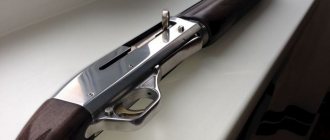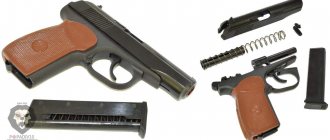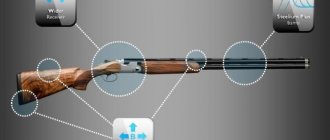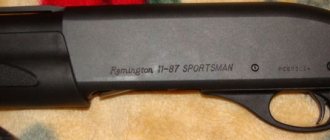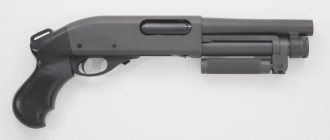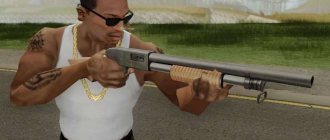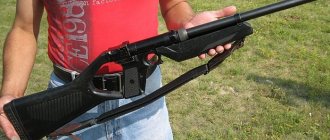The most popular among smooth-bore weapons are 12-gauge hunting rifles. Among the main reasons for this popularity are the following: in such guns you can adjust the size of the powder charge, as well as the weight of the shot charge. In addition, in such hunting rifles you can use any number of shot, buckshot and bullets.
Thanks to this, if you prepare cartridges with a variety of charges in advance, it becomes possible to effectively hunt all types of game from different distances. In addition, this caliber is easiest for beginners to master, unlike guns with other calibers, hunting with which requires a higher level of shooting training.
What is 12 gauge?
The explanation for the barrel diameter of 12-gauge cartridges sounds rather strange - it is the number of round bullets that can be cast from one pound of lead. For 12 gauge, one pound of lead can be cast into twelve round bullets, hence the caliber designation. Compared to rifled calibers, which are measured in millimeters or fractions of an inch, this explanation does seem rather strange. But since it comes from the times of Imperial Great Britain, we have to put up with their conservatism and their system of designating smoothbore calibers.
However, the relationship between barrel diameter and caliber number is quite arbitrary. The diameter of the barrel can be 18.2-19.4 millimeters, depending on the type of gun manufacturer. The actual diameter directly depends on the muzzle constriction, which is called the choke.
Russian 12.7 mm sniper rifles
The development of large-caliber sniper rifles in our country began later than in the West.
But, despite this, Russian gunsmiths managed to create a number of original designs that are not inferior to, and often superior to, foreign designs. The design of the first 12.7 mm sniper rifles in the USSR began in the late 1980s, after it became known that the American special operations forces had adopted rifles chambered for 12.7x99 mm, used for firing from the Browning M2НВ heavy machine gun. However, before the collapse of the Soviet Union, such rifles were not adopted for service.
12.7 mm rifles V-94 and OSV-96
The first serial Russian 12.7 mm rifle was the OSV-96, created in Tula by specialists from the Instrument Design Bureau (KBP).
The prototype of this rifle (chambered 12.7x108 mm), known as the B-94 Volga, was introduced in 1995, apparently shortly before testing it in combat on the territory of the Chechen Republic. Officially, this weapon was intended for firing at the embrasures of firing points, combating lightly armored enemy equipment, destroying radars, vans with radio stations, combat control equipment and missile systems, as well as for destroying enemy aircraft at the airfield.
The large-caliber sniper rifle B-94 is a semi-automatic rifle that works by removing part of the powder gases. The bolt is locked by turning the bolt with four lugs.
12.7-mm rifle V-94 "Volga"
The long barrel and powerful cartridge inevitably affected the overall dimensions of the weapon. The highlight of the design is the ability to fold the rifle, which makes transportation much more convenient.
12.7 mm rifle V-94 "Volga" folded
The barrel of the B-94 rifle is equipped with a muzzle brake-flame suppressor; the butt was originally made of wood. A rubber butt pad is provided on the back of the butt to reduce recoil on the shooter. Shooting is possible only from a prone position or from a support - for which there are folding bipods.
For trial use, rifles with the PSO-1 sight were initially supplied. Subsequently, more durable optical sights with higher magnification were created for the large-caliber rifle.
B-94 rifles of several modifications were produced in small series and were used in the North Caucasus from the second half of the 1990s.
After military tests, the modified rifle was put into service under the designation OSV-96 “Burglar.”
The new modification differs from the B-94 in a modified plastic butt, a different design of the muzzle brake, folding adjustable bipod and carrying handle. Instead of a single-row magazine, a magazine with a staggered arrangement of cartridges is used.
Initially, several rifles of different calibers were developed as part of the Burglar R&D project, but this name “stuck” specifically to OSV-96.
12.7-mm rifle OSV-96 “Burglar” in combat position with accessories.
According to materials published in the public domain, the weight of the rifle without a sight is 12.9 kg. Length in firing position - 1,746 mm, folded - 1,154 mm.
12.7 mm rifle OSV-96 folded
Magazine capacity – 5 rounds. Combat rate of fire – up to 20 rounds/min. The OSV-96 rifle can be equipped with various optical and night optoelectronic sights of domestic and foreign production. The maximum firing range is 1,800 m.
For firing from OSV-96, 12.7x108 mm cartridges intended for DShKM, NSV and KORD machine guns can be used. The B-32 armor-piercing incendiary bullet weighing 48.3 g leaves a rifle barrel 1,000 mm long with an initial speed of 890 m/s and at a normal distance of 300 m is capable of penetrating 20 mm of armor.
Cartridge 12.7×108 mm
Taking into account the fact that standard machine gun ammunition measuring 12.7x108 mm demonstrates unsatisfactory accuracy for a sniper weapon, special cartridges were developed. It is known that for shooting at lightly armored targets an armor-piercing cartridge of improved accuracy with a bullet with a hardened steel core is used.
It is stated that when firing from the OSV-96 rifle, the dispersion diameter of 5 shots at a distance of 100 m does not exceed 50 mm. The best accuracy is provided by cartridges with a bronze bullet turned on a precision machine. But such hand-made cartridges are very expensive and have limited use.
The real characteristics of the “Burglar” with a high-precision cartridge are not disclosed. Based on indirect data, it can be assumed that a “chest figure” type target can be hit with the first shot at a range of up to 800 m.
It was not possible to find information in open sources about how many OSV-96 rifles were produced. In Russia, the OSV-96 is in service with the special forces of the FSB, the Ministry of Internal Affairs and “other law enforcement agencies.”
Large-caliber "Burglars" enjoy some success among foreign buyers. OSV-96 rifles have been adopted for service in Azerbaijan, Belarus, Egypt, India, Iran, Kazakhstan and Kyrgyzstan. Licensed production of OSV-96 has been established in Vietnam in 2022.
These weapons have been used in Syria and eastern Ukraine. Although the first Russian 12.7 mm rifle was mainly intended for shooting at vehicles and suppressing firing points, in real combat it was mainly used as a counter-sniper weapon and in street battles - to defeat personnel hidden behind the walls of buildings and in light field areas. fortifications
Although the OSV-96 is not very accurate for a sniper weapon, the use of the 12.7x108 mm cartridge allows the shooter to remain out of the range of aimed fire from 7.62 mm small arms. Automatic reloading in case of a miss makes it possible to quickly fire again.
12.7 mm rifles SVN-98, KSVK and ASVK
In 1998, the 12.7 mm Nergulenko sniper rifle SVN-98 was presented for testing. Since the first half of the 1990s, work on the creation of this rifle was carried out at the design bureau of the Degtyarev Plant in Kovrov.
12.7 mm SVN-98 rifle
The SVN-98 rifle is made according to the “bullpup” design and uses a longitudinally sliding bolt with a rotation. Food is supplied from a detachable 5-round magazine. The barrel has a compensator brake that reduces recoil and suppresses the flash of a shot. The end of the rifle butt is covered with a porous material, which makes shooting more comfortable. For ease of carrying, there is a handle in the center of the rifle, on which an optical sight is also mounted. Convenience of shooting in a prone position is provided by folding bipods.
Although the SVN-98 rifle was at least as good as the OSV-96 in terms of effective firing range, thanks to the use of the bullpup design, the overall length of the weapon in the firing position is significantly shorter.
At the end of the 1990s, a small batch of SVN-98 rifles was tested in Chechnya. Based on the experience gained in combat conditions, the 12.7-mm KSVK rifle, which differs from the START-98 in a number of details, went into small series.
12.7 mm rifle KSVK
The KVSK rifle without cartridges and an optical sight weighs 12.5 kg. Total length – 1,420 mm. Barrel length – 1,000 mm. The initial bullet speed is 900 m/s. Combat rate of fire – up to 10 rounds/min.
In 2004, an improved, manually reloaded 12.7 mm ASVK rifle was created in Kovrov.
According to advertising information published by the press service of the V.A. Degtyarev Plant OJSC, due to the use of a barrel made by cold forging, shooting accuracy has significantly improved. The average dispersion diameter declared by the manufacturer without the use of special ammunition at a distance of 300 m is about 160 mm. When using special cartridges, the accuracy is about 1.5 MOA.
Guaranteed barrel life without loss of accuracy – 3,000 shots. With proper care, the total barrel life is up to 5,000 shots. A highly effective muzzle brake reduces recoil by more than 2 times. When shooting, a bipod is used, which is attached to the receiver rod. In the stowed position they fold forward. The butt plate is equipped with a shock absorber made of porous material. This allows the shooter to fire several dozen shots without experiencing any discomfort.
Sniper of the 76th Guards Air Assault Division with a 12.7 mm AVSK rifle. Photo: Russian Ministry of Defense
The official entry into service of the AVSK rifle took place in 2014. This rifle is used not only by FSB and FSO snipers, but also in army special forces units. These weapons were successfully used in the armed conflict in eastern Ukraine.
12.7 mm rifle VM-2000
Around the same time as AVSK, the Tula State Unitary Enterprise KBP created the 12.7-mm rifle VM-2000, also made according to the bullpup design.
12.7 mm rifle VM-2000
This rifle took part in a competition announced by the Russian Ministry of Defense, and at the first stage demonstrated very good results. However, the VM-2000 rifle was subsequently removed from testing.
Very little is known about this rifle, no precise information is provided about the device, and it can only be judged from the available photographs. According to information published in open sources, a total of 10 copies of the VM-2000 were manufactured.
The layout of the VM-2000 is made according to the “bullpup” design and has manual reloading with a longitudinally sliding rotary bolt. The cocking handle is moved far forward relative to the breech of the barrel, which makes reloading more convenient. The cartridges are fed from detachable box magazines.
The rifle is equipped with open sights on folding bases and a mounting location for optical or night sights. In front of the fire control handle there is a handle for carrying weapons. To mitigate recoil, the VM-2000 rifle is equipped with a muzzle brake and a shock absorber in the butt. When shooting, support is provided on the folding bipod.
12.7 mm rifle OTs-44
Another large-caliber Russian rifle, made according to the bullpup design, is the 12.7 mm OTs-44. This weapon was designed by the Tula Central Design Bureau of Sports and Hunting Weapons (TsKIB SOO) in the late 1990s for the standard 12.7x108 mm cartridge.
12.7 mm rifle OTs-44
A number of original technical solutions were used in the design of this rifle. So, instead of moving the bolt of the rifle when reloading, the shooter moves the barrel of the weapon. To reduce the sound of a shot, there is a large-sized silencer that weakens the sound of a shot to the level of a 7.62 mm SVD rifle. The weight of the rifle without cartridges is 14 kg. Length – 1,070 mm. Magazine capacity – 8 rounds.
The silencer reduces the initial speed of the 12.7 mm B-32 bullet to 800 m/s. The maximum firing range is 1,200 m. The effective range is 800 m. To radically reduce the noise level of a shot, special cartridges with a subsonic bullet can be used. But at the same time, the effective firing range is reduced by approximately half.
Apparently, when developing this model, the designers tried to create a universal, as compact rifle as possible, which, when fired with conventional cartridges, could be used to destroy various equipment, and with subsonic cartridges - in special operations.
Reliable sources do not contain information about the adoption and combat use of the large-caliber OTs-44 sniper rifle.
12.7 mm rifle VSSK "Vykhlop"
By special order of the Special Purpose Center of the FSB of Russia, in parallel with the large-caliber assault rifle ASh-12 TsKIB SOO, a 12.7-mm special purpose rifle VSSK “Vykhlop” was created, which was put into service in May 2004.
It was first presented to the public at the Interpolitech exhibition in 2005. The main purpose of the 12.7-mm VSSK rifle is to covertly defeat manpower wearing personal protective equipment (including heavy body armor) at a distance of up to 600 meters, as well as those located behind obstacles or light armor.
An acceptable sound level is ensured by an integrated silent firing device and cartridges with an initial bullet speed below the speed of sound (290–295 m/s). The integrated muffler is dismantled for transport or cleaning.
12.7 mm VSSK "Vykhlop" rifles with different optical sight mounts and bipods of various designs
In addition to the possibility of installing various optical and night sights, there are redundant sighting devices: a folding diopter sight and a front sight.
For firing, special STs-130 cartridges with dimensions of 12.7 × 55 mm are used, with specially made weighted bullets, relatively short cartridges 55 mm long and a muzzle energy of about 2.5 kJ.
The range of ammunition for the VSSK rifle includes:
– STs-130 PT cartridge with a high-precision jacketed bullet;
– STs-130 PT 2 cartridge with a bronze bullet of increased accuracy;
– STs-130 VPS cartridge with an armor-piercing bullet;
– training cartridge STs-130 PU, intended for training.
A 12.7 mm subsonic bullet weighs from 59 to 76 g. The total length of the 12.7 mm STs-130 cartridge is 97.3 mm versus 147.5 mm for the standard domestic large-caliber cartridge 12.7 × 108 mm.
At a distance of 100 m, when firing a series of 7 shots with STs-130PT cartridges (a bullet weighing 59 g), they fit into a circle with a diameter of 35 mm. A bullet from the STs-130VPS cartridge weighing 76 grams normally pierces a steel plate 16 mm thick at 200 m. In addition to armor, such a cartridge can easily pierce a wooden wall or brickwork up to 10 cm thick.
Reloading the VSSK is done manually. The bolt handle is located on the right side of the rifle and moves progressively, which is more ergonomic than handling a traditional bolt with a turn. On the handle connected to the bolt frame there is a pre-release lever and a handle safety device that prevents spontaneous opening of the bolt. The barrel bore is locked by turning the bolt onto four symmetrically located lugs.
The rifle has good ergonomics and can be fired from any position. There is a pad on the butt plate that can be adjusted to suit individual needs. At the front of the rifle there is a folding bipod. In the stowed position, they are completely retracted into the fore-end and have an adjustable height.
For a 12.7 mm caliber, the VSSK has very modest weight and dimensions. The weight of the rifle with magazine, silencer and without sight is 6.5 kg. Length – 1,125 mm. Food is supplied from a detachable 5-round magazine.
Evaluation of the effectiveness of domestic 12.7 mm sniper rifles
Concluding the review dedicated to Russian 12.7 mm rifles, we can state that their characteristics are not inferior to the best foreign models.
Thus, the OSV-96 self-loading rifle is quite comparable in size, rate of fire and accuracy to the Barrett M82. At the same time, a domestically produced rifle is cheaper, lighter, can be folded for transportation, has a longer barrel and higher-power ammunition, which potentially allows it to hit targets at a greater range. Russian 12.7 mm rifles with manual reloading, built according to the bullpup design, look quite decent against the background of the American Barrett M-90/M-95/M-99.
Not only in the USA, but nowhere in the world there is yet a serial analogue of our low-noise rifle VSSK “Vykhlop”.
At the same time, it should be noted that the ammunition load of Russian large-caliber rifles lacks modern armor-piercing incendiary cartridges, similar in their characteristics to the American MK 211, which, in turn, does not allow the full potential of the domestic 12.7x108 mm cartridge to be fully revealed.
It is also highly desirable to improve the quality and characteristics of domestic optical and night sights. It is no secret that FSB and FSO snipers often use foreign-made optics.
Currently, Russian large-caliber sniper rifles are mainly available in services involved in the fight against terrorism, the physical protection of top officials and the protection of strategically important facilities. Compared to the American armed forces, there are still few 12.7 mm rifles in our army.
Important features of the choke
The dispersion of shot is regulated using the muzzle constriction. Since different manufacturers have “disagreements” in the sizes of chokes, the accuracy of the shot for different types of 12-gauge smoothbore shotguns cannot be the same. An accurate accuracy indicator can only be achieved after carefully zeroing the gun.
Chokes are divided into several types, which differ in the diameter of the constriction.
Their main types:
- the cylinder has a narrowing of 0.00-0.02 millimeters. This gun does not have a choke and can be used with any type of cartridge. The ideal shooting distance from a gun with such a choke would be 15-25 meters. Also, when fired from it, a uniform scattering of shot is observed.
- The next type of choke has a narrowing of 0.15-0.25 mm and is called a cylinder with pressure. This type has a slight narrowing, which makes the dispersion of the shot smaller. Accuracy is no more than 40%. It is better to shoot from a distance of 20-25 meters.
- the patch has a scree accuracy of at least 55%, the size of its narrowing is usually 0.50 mm. Buckshot and shot of any number can be used, as well as round and sub-caliber bullets with flanges.
- The constriction size of the average choke is 0.75 millimeters with a dispersion accuracy of 60%, which is achieved when fired from a distance of more than 50 meters. Large shot and a certain type of buckshot are suitable for this choke. Bullets can only be sub-caliber or specially selected for this choke.
- A full choke with a constriction size of 1.00 millimeters is suitable for shooting with medium-sized shot, which is fired at maximum distance. Accuracy is 70%; if you shoot in large numbers, this will negatively affect the uniformity of the scree. Sub-caliber bullets must be used.
- The rarest type of choke is reinforced, with a narrowing of 1.25 mm. Shot accuracy is 85%, while shooting is carried out from a maximum distance with shot number 7-10.
- a special or very strong choke can only be seen in exclusive guns from a domestic manufacturer. The size of the narrowing is 1.40-1.45 millimeters. Fractions from 8 to 10 numbers are used. The use of bullets or buckshot is not allowed.
Photo by ASVK Kord
KSVK/ASVK Kord 6V7 - 12.7 mm large-caliber sniper rifle
KSVK/ASVK Kord 6V7 - 12.7 mm large-caliber sniper rifle
KSVK/ASVK Kord 6V7 - 12.7 mm large-caliber sniper rifle
Rules for choosing this type of gun
To choose the right 12-gauge hunting rifle, you should proceed from the type of hunting for which this rifle will be intended. An experienced hunter himself understands which weapon is suitable for him personally, however, he cannot do without recommendations that it is advisable to follow in order not to make a mistake in choosing a weapon. A novice hunter needs to familiarize himself with them carefully.
Let's imagine an average store that sells weapons. Let's consider 12-gauge shotguns as the most accessible for a hunter who does not have sufficient experience.
The choice of cartridges for such a gun consists of two options: a standard cartridge with a 70 mm sleeve and a magnum with a 76 mm sleeve. Many experienced hunters disapprove of magnum cartridges, believing that they are not necessary for regular hunting.
According to the type of action, there are three types of reloading for 12 gauge, namely manual or mechanical, automatic and using a pump. A gun with manual reloading is chosen by those who like simplicity and reliability; such reloading is done by simply breaking the gun. If you choose a gun with automatic reloading, then get ready for more complex and expensive maintenance of such weapons. Despite the many advantages of semi-automatic reloading, such guns weigh a lot, which will cause a lot of inconvenience during hunting.
You should also pay attention to the number of barrels: if you choose manual reloading, then it is better to buy a double-barreled shotgun; a single-barreled shotgun is suitable for true masters of their craft who do not miss.
And the last simple but effective piece of advice is to take your time when choosing a gun. Select it carefully, weighing all the pros and cons, consider its weight and how it “lies” in your hand. Carefully study the quality of the materials; you can evaluate the operation of the mechanism by listening to the gun - there should be no extraneous sounds when the barrels are closed.
Also, you should not follow the lead of advertising, since any manufacturer will praise their product and remain silent about the shortcomings. Pay attention to the ratings compiled by professionals who have dealt with guns presented in stores.
Advantages and disadvantages of the IZH-12 hunting rifle
The production quality of IZH-12 hunting rifles is significantly superior to modern products from IZHMASH and Kalashnikov Concern, while they delight with their reliability when working in the most difficult conditions. The main advantages of IZH-12 lie in its design:
- The simplest design of the IZH-12 hunting rifle is devoid of complex weapon components, which not only simplifies disassembly of the weapon, but also makes its operation trouble-free. The fewer complex components, the higher the reliability of the weapon; this rule has long been known to all hunters;
- Quite attractive and modern appearance. IZH-12, despite the fact that more than 40 years have passed since the release of the last gun of this model, still looks quite modern. The classic design, combined with the wooden parts of the IZH-12, makes this gun quite attractive even for the modern hunter;
- This gun can be purchased for an extremely low price, since most of the original owners of guns of these models have not gone hunting for a long time.
The excellent combat quality, accuracy and balance of the IZH-12 gun make this weapon a true classic that many experienced hunters want to have.
Like any weapon, IZH-12 has specific disadvantages due to its design:
- The design of the gun is rather rough, although some hunters like such brutality;
- The specific shape of the gun requires the use of a forend that is too thin, which can break if used carelessly. Vertical double-barreled shotguns, which have a composite fore-end, do not have this drawback;
- The aiming bar is at a slight angle to the butt. This feature can lead to misses in the initial stages of shooting, but with experience you can get used to this feature, simply taking this nuance into account when aiming;
- The triggers are too close together. This feature leads to the fact that it can be inconvenient to move your finger from trigger to trigger, although this largely depends on the anatomical characteristics of a particular hunter. Some hunters refuse to purchase this double-barreled shotgun precisely because of this feature.
List of 12-gauge shotguns by popularity
In the rating described below, we will ignore guns produced by such well-known companies as Benelli, Beretta and Browning. They are quite expensive that they stand outside of any ratings and comparisons. Hunters who choose a gun from one of these manufacturers are most likely not buying their first gun and are well aware of what they want from their gun.
The following brands are popular among hunters choosing a gun in the mid-price range.
The leaders, of course, are weapons produced by domestic factories located in Izhevsk and Tula.
- The first place is occupied by the MP-153 and MP-155 shotguns.
- The second place is confidently occupied by two guns, which are double-barreled shotguns with vertical barrels of 12 gauge Izh-27 and TOZ-34.
- In third place are Turkish semi-automatic devices from various manufacturers, which are becoming more and more popular among our hunters every year
- Fourth place was taken by various modifications of Tula rifles, created on the basis of the legendary TOZ-BM.
- The fifth place occupied by “Saiga” was given to it not so much for the merits of this weapon, but for its popularity in our country. But, in any case, this is not the worst weapon.
Guns from Izhevsk
The Izhevsk Mechanical Plant produces weapons that are famous for their excellent quality and reliability in use. There is not enough space to list all the models of 12-caliber IZH shotguns, so let's talk about the most popular single-barreled and double-barreled shotguns.
- The legendary hammerless single-barrel IZH-18 can still be found hunting. This gun is considered a “pioneer” in the field of 12-gauge fishing.
- Three modifications created on the basis of one model - IZH-54, IZH-58, IZH-43 - several generations of hunting enthusiasts “grew up” on them.
- Based on the well-known IZH-12, the IZH-27 was created, which became even more popular. It is reliable and has many advantages over analogues, which will allow you to use it for many years.
- It is impossible not to mention the semi-automatic shotguns produced in Izhevsk, MP-153 and MP-155.
Design features of the IZH-12 hunting rifle
The Izh-12 shotgun is perfect for hunting, both for beginners and for experienced hunters. Since in the 60s in the USSR much attention was paid to the quality of manufacturing of hunting weapons, the IZH-12 is distinguished by high-quality execution and assembly. The gun barrels are made of high quality weapon steel, and the hardening of the barrel is uniform along the entire length. Unfortunately, in modern guns the hardening is often extremely uneven.
The barrels of the IZH-12 hunting rifle are soldered together with one interbarrel strip, and a silver-based alloy was used as solder. In order to increase the life of the weapon and make it easier to care for, the chambers and barrel channels were carefully coated with chrome.
In IZH-12, the barrel channels have a continuous narrowing along the entire length of the barrel, with only the upper barrel having a complete narrowing. The difference between the narrowing of the upper and lower trunk is 0.5 mm. It turns out that if the upper barrel has a choke, then the lower one has only a choke. The brass front sight, which is raised above the aiming bar by 3 mm, simplifies the aiming process.
The block is made of mild steel and has a deep cutout. At the bottom of the block there are windows for special under-barrel hooks. Immediately after the block, there is a shank containing a sear and a safety mechanism. Since the design of the IZH-12 provides for the presence of an interceptor, the function of which is to prevent an accidental shot from the cocking, the IZH-12 is considered a fairly safe hunting rifle even in inept hands.
TOZ - the best examples of 12 gauge
Since ancient times, Tula has been famous for its weapons, and Tula craftsmen have always competed with representatives of the Izhevsk weapons profession. Thanks to the centuries-old traditions of weapons production, Tula TOZ guns are in no way inferior in popularity to their Izhevsk counterparts. If we look at the 12-gauge TOZ shotguns in more detail, we should highlight the following models:
- The gun popularly called “tulka” has the correct name TOZ-BM, but all further produced models created on this basis remained “tulkas”. The barrel is made of excellent steel, the trigger mechanism is reliable, and the shooting characteristics of the “barrels” are so good that they served as an example for the creation of subsequent generations of hunting weapons based on them.
- After TOZ-BM there was a legacy and its name was TOZ-80. When creating it, Tula craftsmen took into account all previous developments and released an improved model.
- The most popular among 12-gauge shotguns produced in Tula is the TOZ-34 over/under. Its main competitor is the IZH-27 vertical barrel shotgun from Izhevsk. The hunters split into two camps and there are still fierce debates about which of the two guns is better.


